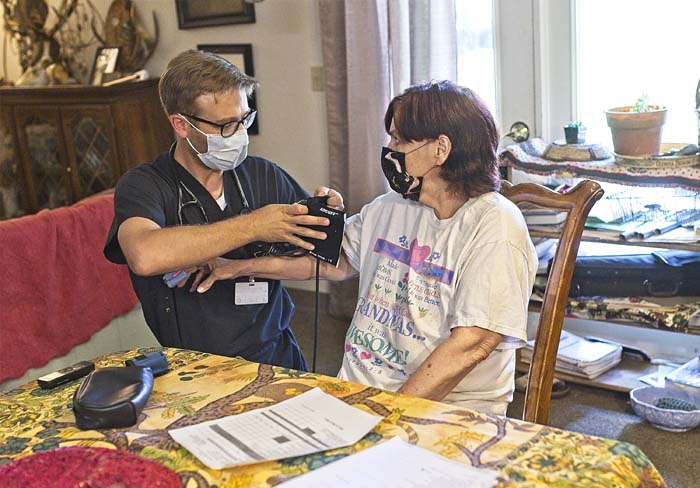Wallowa County’s Winding Waters Community Health Center reinvents the horse and buggy
Published 3:00 am Friday, June 19, 2020

- Dr. Wes Baker begins a blood pressure check for his patient.
A century ago, a rural doctor often was a lone practitioner who might have traveled by horse and buggy, rendering care to patients in their homes. At the end of a long day and a longer night, the physician sometimes fell asleep and the horse dutifully took the buggy and doctor home.
In very rural Wallowa County, Winding Waters Community Health Center has revived that age-old tradition, with several new twists. After starting a limited program of home visitation last year and spurred by the need for home care of vulnerable patients in a time of the COVID-19 pandemic, Winding Waters now dispatches two physicians to provide home-care each day. The increase in home care comes courtesy of a federal grant from Health Resources and Services Administration.
The practice is proving so popular with patients, and medically valuable for physicians, that the clinic plans to provide at least one “roving” doctor each day to meet demand even after the need for special coronavirus-related precautions subside. Most of the physicians who work at the clinic will participate in the program, said clinic CEO Nic Powers.
A typical home visit takes anywhere from 30 minutes to an hour, depending upon patient needs. Winding Waters practitioners aim for 8 to 10 home visits per day.
And this is 21st century home-care. A cell phone connection link to Winding Water’s main offices in Enterprise allows the clinic staff to record vital signs, physician recommendations, prescription orders and patient comments. Should there be a need for a specialist, a second physician or a counselor, they can participate on the same phone link. If the patient is within cell range, physicians can deploy an internet hotspot and if need-be, access additional services via the internet.
Each visiting physician takes four large cases of medical equipment and supplies. The sophisticated portable equipment includes a portable ultrasound machine. “On most visits,” said physician Wes Baker, “I usually only take in the basic medial equipment bag and maybe one other. But it’s reassuring to know the rest is available.”
“The home visitation program gets you out of the office and gives you some downtime to think about things, including patients’ needs, while you are driving from one home to another,” said Dr. Geoff Maly. “It’s sort of a de-stressing activity. But it also means more time at the end of the day to catch up on all the administrative things that I have to do.”
Those drives are not inconsequential. Much of Wallowa County’s mountains, canyons and grasslands are accessible only by rural back roads. While most visits are in or close to the communities of Wallowa, Enterprise and Joseph, some are in (very) rural areas. Physicians try to schedule as many visits as possible in a cluster within one community, but that’s not always possible.
“We had one home visit for end-of-life care that was a two-hour drive home to visit, that’s a two-hour drive from the clinic in Enterprise,” Powers said. That’s an unusual case. But it substantially improved the care and saved the patient from a grueling four hours in a vehicle. A home visit to Imnaha requires about an hour’s drive one way. To the small town of Troy, about an hour and a half. Those long distance visits, Powers said, would usually be done by an RN rather than a physician, with a physician tuned in by internet or cellular connection.
“This is primarily a physician visiting a patient,” Powers said. “It’s not just another form of telemedicine. Their medical assistant can be online listening and taking notes. Documentation is done properly, any lab tests or prescriptions are ordered.”
There are no firm guidelines on who can be seen at home. Conditions that frequently get attention at home include dementia patients who have a hard time with transportation and need caregiving, and those with mobility issues.
“I’ve done well-child checks for kids, and seen pregnant patients at home,” Maly said. “I’ve visited patients who simply couldn’t get child care and visiting their home was the only way they could be seen. It’s really the full spectrum of patients that we’re seeing, all the way from giving shots to caring for patients at the end of life.”
Home visits can provide invaluable insight to the patient’s well-being and support system.
“You can kind of see who’s there to support them and what kind of environment surrounds them on a day to day basis,” Maly said. “If there’s a caregiver, you can talk with them and get some additional insight. Often patients are more relaxed when seen at home, without the stress of dealing with appointments, strangers and multiple medical staff.” Maly said on a home visit he checks the patient’s blood pressure, temperature and oxygen saturation.
“I have had to draw blood, which is something I hadn’t done since medical school,” he said. “But it really puts you in a closer one-on-one relationship with your patient.”
When Dr. Wes Baker stopped to check in on one of his patients recently, she and her caregiver cheerfully related her problems with medications she was taking, changes in her foods and eating, and other issues. It was obvious that there was a strong bond of trust that had developed between physician, patient and caregiver.
When asked whether she would prefer to visit Baker at the Joseph Clinic, or receive more home visits, Shellie gave home visits a resounding yes! “I think this is the best thing ever,” she said.







